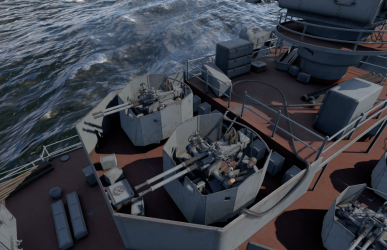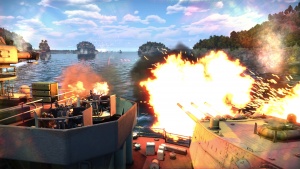37 mm/67 70-K (37 mm)

Contents
Description
The 37 mm/67 70-K is a Soviet naval anti-aircraft cannon, mounted in single and quad configurations on a wide range of Soviet vessels. A twin-mount water-cooled variant was also developed, designated the V-11.
Vehicles equipped with this weapon
| Vehicles equipped with this weapon | |
|---|---|
| Motor gun boats | OD-200 |
| Armoured gun boats | BMO · MBK pr.186 · MBK pr.186 (MK 85) · MBK-161 early · MBK-161 late · Pr.1124 late |
| Gunboats | Groza |
| Sub-chasers | MPK Pr.122bis · MPK-163 |
| Frigates | Karl Marx · Rosomacha · Yenot |
| Destroyers | Besposhchadny · Bezuprechny · Leningrad · Ognevoy · Opytny · Ryany · Smelyi · Soobrazitelny · Stroyny · Tashkent |
| Light cruisers | Chapayev · Kerch · Krasny Kavkaz · Krasny Krym · Mikhail Kutuzov · Shcherbakov · Sverdlov · Voroshilov · Zheleznyakov |
| Battlecruisers | Kronshtadt |
| Battleships | Marat · Novorossiysk · Parizhskaya Kommuna |
General info
This gun fires quickly for its size, with a reload time of 0.43 seconds stock, 0.33 seconds with an expert crew. The mount is fully traversing, limited only by objects in its way such as other guns or parts of the ship. The gun is able to elevate to an almost vertical position, giving it the ability to fire at anything it pleases.
Available ammunition
On the coastal ships Yenot and Rosomacha, you have a choice between Universal (50/50), HE (5 HEF-T/1 AP-T), or AP (1 HEF-T/5 AP-T).
Universal is very useful as it is able to damage both aircraft and lightly armoured ships severely. With how fast the gun can fire, only half of the belt being HE is not an issue against aircraft, and the same holds true for the AP rounds against other vessels.
Comparison with analogues
Compared to the earlier 45 mm/46 21-K, the 70-K fires 5 times faster while not sacrificing too much explosive mass.
The 40 mm Bofors guns found on many American and British vessels have almost identical performance to the 70-K.
The 37 mm guns found on German ships have far lower fire rates, while the 37s found on Italian ships are either better (Breda mod.38/mod.39) or far worse (Breda mod.32).
The Japanese have no direct counterpart, the closest being their trusty 25 mm mounts which have a fire rate 5 times slower.
Usage in battles
This gun is best used as it was designed: to crush enemy aircraft with its devastating fire rate and high-explosive shells as well as smother enemy lightly-armoured vessels with its armour-piercing rounds. This mount does not have the best horizontal traverse rate, so it is advisable to take control of the turrets and rotate them towards the target you want them to engage before they come into range and you turn it over to the AI.
Pros and cons
Pros:
- High fire rate, can devastate enemy aircraft/light vessels easily.
- Near-perfect vertical guidance, aircraft cannot avoid this weapon by attacking from directly overhead.
- Far better effective range compared to the 20 mm cannons found on earlier ships.
Cons:
- Somewhat slow traverse rate, skilled pilots can easily evade AI gunners.
History
The 37 mm/67 70-K is a naval variant of the Soviet 61-K anti-aircraft gun. The design is based off the 25 mm Bofors model 1933 naval anti-aircraft gun which was sold to the Soviet Navy for trials in 1935. The navy originally intended for it be scaled up to 45 mm, but their attempt failed so they settled for scaling it up to 37 mm creating the 61-K which was one of the main Red Army anti-aircraft guns during World War II. The 70-K version was adapted for naval use in 1938 and was adopted by the Soviet Naval in 1940. Replacing the larger semi-automatic 45 mm/46 21-K as the navy's main anti-aircraft gun, 1,641 70-Ks were built making it the main automatic of the Soviet Navy during the war and 3,113 were ultimately built when production ended in 1955. Not the most exceptional weapons in the world, they were good enough for the Soviets which was what they needed at the time and it would serve alongside its army counterpart the 61-K in multiple conflicts during the second half of the 20th century.
The V-11 was a twin-barrelled variant. During World War II, the 70-K was the main automatic weapon in the Soviet Navy, however, it suffered from a short barrel life of only 100 rounds. This problem was noted by the Soviet Navy early on and they were already working on making twin-mount and quad-mount variants before the German invasion in 1941. The dual-mount version was still being tested when Operation Barbarossa occurred and was swiftly cancelled as was the quad-mount version, though the latter prototype saw action installed on the Oktyabr'skaya Revolutsiya. Work on the dual-mount version would continue after the war creating the V-11, which is water-cooled instead of air-cooled like the 70-K and 61-K. The V-11 was adopted in 1946 and gradually replaced the 70-K until production ended in 1957. The V-11 along with the 70-K were replaced by the dual 57 mm ZIF-31.
China also notably produced two variants of the V-11. Their regular twin-mount was the Type 65, which was later replaced by the Type 75 which mounted the gun in a turret to serve as a CIWS.
Media
See also
- 61-K (37 mm): Army counterpart
External links
| Germany naval cannons | |
|---|---|
| 15 mm | MG 151 |
| 20 mm | 2 cm/65 C/30 · 2 cm/65 C/38 · 2 cm/65 Flakzwilling 38 · 2 cm/65 Flakvierling 38 · MG 151/20 |
| 30 mm | MK103/38 |
| 37 mm | FlaK-Lafette C/36 · 3.7 cm FlaK-Lafette LM/42 · SK C/30 · FlaK.36 · FlaK43 |
| 40 mm | 40 mm/70 MEL58 · Bofors Flak 28 · Bofors L/70 model 1948 |
| 52 mm | 52 mm/55 SK L/55 |
| 88 mm | 8.8 cm/76 SK C/32 · S.K.C/35 · FlaK.18 · Flak.36 · 88 mm/45 AA SK L/45 · 88 mm/45 casemate SK L/45 |
| 100 mm | 100 mm/55 MLE model 53 |
| 105 mm | SK C/32 · SK C/33 AA |
| 120 mm | L45 |
| 128 mm | 12.8 cm/45 SK C/34 · 12.8 cm SK C/41 |
| 150 mm | 150 mm/45 SK L/45 · 15 cm/48 KC/36 · 15 cm/55 SK C/28 · 15 cm/60 SK C/25 |
| 203 mm | 20.3 cm/60 SK C/34 |
| 283 mm | 283 mm/45 SK L/45 · 283 mm/52 SK C/28 · 283 mm/54,5 SK C/34 |
| 305 mm | 305 mm/50 SK L/50 |
| 380 mm | 38 cm SK L/45 |
| Foreign: | |
| 23 mm | ZU-23 (USSR) |
| 25 mm | 2M-3 (USSR) |
| 30 mm | AK-230 (USSR) |
| 37 mm | V-11 (USSR) |
| 76 mm | 76 mm/62 OTO-Melara Compact (Italy) |
| 100 mm | 100 mm/56 B-34 (USSR) |




